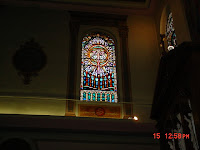
I wish this and the next few had captured a bit more of the artist's use of vibrant colours. Even so, you can get the idea of the grandeur of this painting, and perhaps have an inkling as to why the man who painted it was among the select group of people to be nicknamed "Canada's Michelangelo".
His name was Guido Nincheri. He was born in the small town of Prato, in Italy, in 1885. In 1914 he and his wife left for a honeymoon in Argentina, only to be stranded in Boston on account of the outbreak of World War I. With no way to go home, Guido and his wife went to Montreal instead, where he found a job as a painter, and eventually began decorating churches. Demand for his skills spread, and he was soon moving throughout Quebec, Ontario and the Maritimes and the Northeastern United States. In all, he painted for over one hundred churches, including Cathedrals like Holy Rosary Cathedral, in Vancouver, BC, Canada before his death in 1973.
He was also famous for his stained glass windows, and St Clare's is fortunate to have four of his windows. They depict Mary, Queen of Heaven, the Holy Spirit, The Triune God, and St. Peter




Again, though not my best pictures, they can give you an idea of the bold use of colour, and jewel like nature of the windows. When the sun shines through the windows in the morning, or with the sunset, the effect is absolutely beautiful.
There's a funny story about our good painter here. He was at work in the new church in Montreal, Madonna della Difesa, and painted there the largest frescoes of the time. The archbishop and parish council decided they wanted to commemorate the the Lateran treaty 1929, which recognized the Vatican as a separate state, by ordering a portrait of one of the treaty's founders, Benito Mussolini, in the church's main hall.
Nincheri was loath to paint the dictator and dragged his feet on the project, until one night the pastor and three of the church wardens showed up at his door for a little talk. In short, they threatened to tear up the contract if he did not paint the picture. And so Nincheri fulfilled his contract and made the painting.
Come September the 10, 1939, Canada declared war on Germany and also Italy. Soon afterward Nincheri got another visit, this time from the RCMP. I can see in my mind something of how that visit went. Picture a bare, windowless room, with a table and a chair, Guido in the chair, a bright light shining in his face, and a burly officer leaning on the table saying: "So, you like to paint pictures of Canada's enemies, eh?"
No comments:
Post a Comment